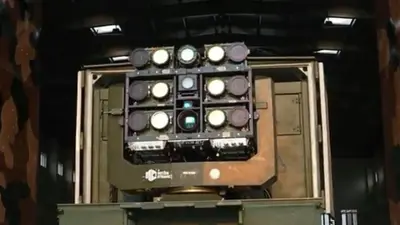Top Stories
Indian Armed Forces Order 16 Advanced Laser Anti-Drone Systems

The Indian Army and Indian Air Force have announced plans to enhance their capabilities against unmanned aerial threats by ordering 16 indigenous laser anti-drone systems. These systems will be capable of targeting enemy drones at a distance of 2 kilometers using laser technology, with potential strike capabilities extending to 5 kilometers with a more powerful weapon.
Advanced Technology and Capabilities
The Defence Ministry is expected to approve the Integrated Drone Detection and Interdiction System (Mark 2), developed by the Defence Research and Development Organisation (DRDO). This system features a 10-kilowatt laser, which will allow the armed forces to engage drones at double the previous range of 1 kilometer. Defence officials confirmed that this advancement comes in response to increasing threats posed by enemy drones.
Recent conflicts have highlighted the importance of effective drone countermeasures. Notably, during Operation Sindoor, adversaries utilized drones extensively, prompting the need for robust interception systems. The DRDO is actively developing long-range laser-based detection and interception mechanisms to address this challenge.
In a significant development, the DRDO has successfully tested a 30-kilowatt laser-based direct energy weapon that can engage targets at distances of up to 5 kilometers. These trials are conducted in collaboration with Indian defence forces, marking a critical advancement in India’s military capabilities.
Field Demonstration and Future Prospects
This past April, India showcased its ability to neutralize various aerial threats, including fixed-wing aircraft, missiles, and swarm drones. By demonstrating the effectiveness of the 30-kilowatt laser-based weapon system, India joined a select group of nations, including the United States, China, and Russia, that possess similar technologies.
The Centre for High Energy Systems & Sciences (CHESS), a laboratory within the DRDO, successfully conducted a field demonstration of the Land version of the Vehicle-mounted Laser-directed Weapon DEW MK-II(A) at Kurnool, Andhra Pradesh. This demonstration effectively neutralized unmanned aerial vehicles and swarm drones, causing significant structural damage and disabling surveillance sensors.
As the role of drones in modern warfare continues to expand, the Indian Armed Forces recognize the necessity of acquiring the Integrated Drone Detection and Interdiction System in large quantities. Dr. Samir V. Kamat, the chief of the DRDO, indicated that ongoing research will also focus on developing additional high-energy systems, including high-energy microwaves and electromagnetic pulse technologies, aiming to bolster India’s defensive capabilities further.
As the security landscape evolves, these advancements will play a crucial role in ensuring that the Indian Armed Forces remain prepared to face emerging aerial threats effectively.
-

 World4 months ago
World4 months agoSBI Announces QIP Floor Price at ₹811.05 Per Share
-

 Lifestyle4 months ago
Lifestyle4 months agoCept Unveils ₹3.1 Crore Urban Mobility Plan for Sustainable Growth
-

 Science4 months ago
Science4 months agoNew Blood Group Discovered in South Indian Woman at Rotary Centre
-

 World4 months ago
World4 months agoTorrential Rains Cause Flash Flooding in New York and New Jersey
-

 Sports4 months ago
Sports4 months agoBroad Advocates for Bowling Change Ahead of Final Test Against India
-

 Top Stories4 months ago
Top Stories4 months agoKonkani Cultural Organisation to Host Pearl Jubilee in Abu Dhabi
-

 Science4 months ago
Science4 months agoNothing Headphone 1 Review: A Bold Contender in Audio Design
-

 Top Stories4 months ago
Top Stories4 months agoAir India Crash Investigation Highlights Boeing Fuel Switch Concerns
-

 Sports4 months ago
Sports4 months agoCristian Totti Retires at 19: Pressure of Fame Takes Toll
-

 Business4 months ago
Business4 months agoIndian Stock Market Rebounds: Sensex and Nifty Rise After Four-Day Decline
-

 Politics4 months ago
Politics4 months agoAbandoned Doberman Finds New Home After Journey to Prague
-

 Top Stories4 months ago
Top Stories4 months agoPatna Bank Manager Abhishek Varun Found Dead in Well








